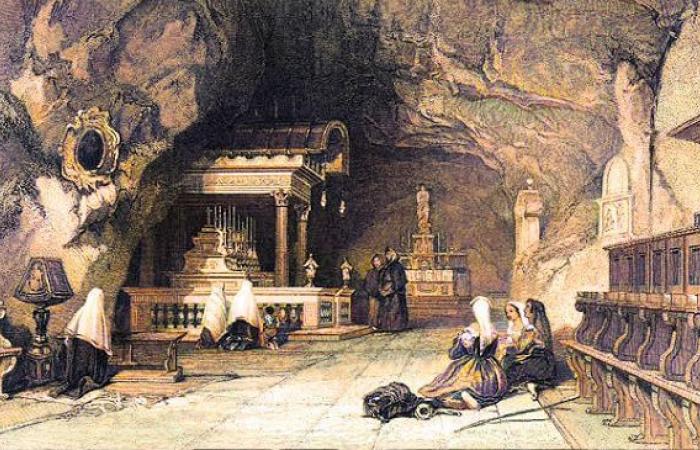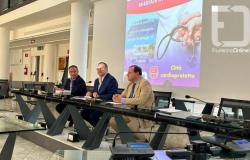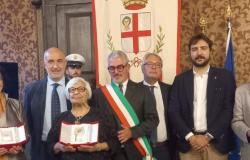Rich in mosaics inside a sacred place, it seems that Santa Rosalia lived here for about 6 years until her death. For this reason it took the name of “Church of Santa Rosolea”
Between mysteries and legends, Rosalia Sinibaldidaughter of Sinibaldo Sinibaldi Lord of Monte delle Rose and Quisquina member of the Marsi family descendant of Charlemagne, her mother Maria Guiscardi granddaughter of King Roger II, is not certain. The Palermo Senate commissioned the Jesuit Cascini in 1631 to collect information on her life, the writing was then inserted in the urn of the remains of the Saint kept in the Cathedral of Palermo.
The first news is an inscription carved in a Quisquina caveit is said to have been made by the Saint, found by some bricklayers, the object of numerous doubts. Caetani collected the oral tradition, in addition to the codices in which she was mentioned, which saw her arrive in Palermo as a lady-in-waiting of the queen, living at the Olivella where it seems, the first chapel in his name was erected.
Today, of the house and place of worship, there remains a well inside the 17th century courtyard of theOratory of Santa Caterina. Tradition has it that on her wedding day she saw the image of Christ who invited her to leave everything and live as an anchorite. The choice was immediate, she cut her blond braids and decided to become a Basilian hermit.
Adv
The mendicant and eremitic orders were very strong in that period and saw many women choose solitude, discretion, spiritual mortification, “spiritual water and food”. Some of these had themselves walled up leaving only a small crack, some went to live in the burial grounds, others dug the friable rock making a well as a cell.
The Basilians were forced to flee from the East during the war against the sacred images and found refuge precisely between Sicily, Calabria, Abruzzo, Puglia and Basilicata, welcomed with enthusiasm by the Norman kings. Whether it was Basilian Rosalia is witnessed by the images that portray her with the typical session, moment and with the attributes that are often attributed to monks: the stick, the bag, the shell around the neck, sometimes the dog, the giglio symbol of purity, a bowl and a skull.
Rosalia brings together almost all these symbols, including the famous crown of roses for some white for others red. After all name omenin its name the omen, in fact, the two flowers appear, the rose and the lily, the lily.
The first experience of hermitage was probably in woods of Palazzo Adriano before Quisquina, Bivona where she lived for 12 years before returning to Palermo on the sacred mountain, Monte Pellegrino, some say following the request of the Queen, others say she was transported by an angel.
In that same place it seems there was a pre-existence Byzantine church with a typical square shape internally structured in the shape of a Latin cross decorated with paintings or mosaics, later dedicated to the cult of the Saint and called “Church of Santa Rosolea“The Phoenicians also knew that the Mountain was a magical ritual place and they built a rock sanctuary inside those rocks that oozed water.
The Saint lived there for about 6 years asking to be walled up in one of the recesses of the cave. She died around 1170 at the age of about forty.
The cult of the Saint remained linked to the invocation over time, and even the small Byzantine-Norman church was forgotten. All this until 1624 when a ship from Tunis brought the across the river in the city.
Palermo was completely prostrate in the grip of disease, until the Saint appeared for the first time to a sick woman, indicating the place where her remains were found. Cardinal Doria decided to start excavations to find access to the “peregrine cell”, as it was called.
The search was frantic, the plague raging required strong actions, the Church was almost destroyed. The remains were found fused “embedded in a shell of crystalline rock”, calcarenite. Doubts about the discovery, the analyses continued for several months, until the Saint manifested herself again to the “soap maker” Vincenzo Bonelli.
Rosalia led him in 1625 near the ancient Church of “Santa Rosolea” inviting him to have her relics exposed as soon as possible without delay or doubts. This was done, the remains were transported and the disease was defeated and Rosalia became the Patron Saint of the city.
The little church was razed to the ground to make room for the Baroque church with the adjoining convent. Thus the place where Rosalia lived and prayed in solitude, a place probably built on the Phoenician remains, was definitively lost.
A huge loss, which could have told us something more not only about the Saint, but about the place of worship through inscriptions, decorations, foundations, furnishings. A sacred place that continues its protective function of the City and its inhabitants.
The Saint’s celebrations are known from the July Festino in which the triumphal Cart of the Saint parades and in September, the date set by the Hagiography, of the death of Rosalia, with the “Acchianata” on foot of the Palermitans. Strange that the climb is also done by the Tamil Indians who have found analogies between the Sicilian Saint and one of their female divinities.
Myth, Rite and History, difficult to order, to establish what comes first, Rosalia like all the holy Thaumaturges touches the three points, passing from legend to history. Yet for those of us who live in a world that day by day disowns truths and certainties that seemed acquired, returning to rely on the supernatural can be of great comfort.
This year, our Santuzza will be represented in a white statue with her arms outstretched to embrace everyone with a sweet cerulean look, as if to say, I borrow a few words: «You’ll be scared, ’cause I’m dreaming» and that’s enough for us.
Long live Palermo and long live Santa Rosalia.






